Half of Madagascar’s frogs may still await discovery
An interview with Dr. Franco Andreone:
Half of Madagascar’s amphibians may still await discovery
Jeremy Hance, mongabay.com
March 11, 2008
Madagascar is one of the most unique places on Earth for wildlife. When the public thinks of Madagascar’s fauna most likely they think of one of the fifty species of lemur. Yet, Madagascar possesses a wealth of endemic wildlife outside of these unique prosimians. For example, to frog-lovers Madagascar is a paradise. The only amphibians living on Madagascar are frogs; the island is devoid of toads, salamanders, or newts. But what it lacks in other amphibians it makes up for in the number and beauty of its frogs. These include a genus called the Mantella. Endemic to Madagascar, they are startling in the brightness and variety of their colors, making them extremely popular in the pet trade. Yet their popularity as pets and the destruction of their habitat has made many of these brilliant frogs critically endangered. Currently, 240 frogs have been catalogued in Madagascar, 99 percent of which are endemic. Yet, amphibian expert Dr. Franco Andreone believes that, according to recent field studies, this may only be half of the frogs that actually live in Madagascar. Dr. Andreone believes the final tally could reach 500 species!
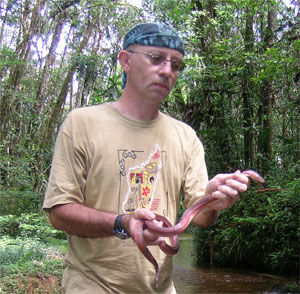 Dr. Franco Andreone. |
Dr. Franco Andreone may be best described as a Renaissance-man of herpetofauna. He is chair of the Amphibian Specialist Group, coordinator of the ACSAM Initiative, and curator of zoology at MRSN.
The native Italian is a sought-after expert for both Europe’s and Madagascar’s rich herpetofauna. He has worked with such conservation organizations as the World Wildlife Fund, EDGE, World Conservation Society, and the IUCN. In addition, Dr. Andreone is the curator of the Museo Regionale di Scienze Naturali in Torino, Italy. He spends the majority of his time here, yet visits Madagascar on various field trips often—spending nearly a quarter of the year there. He is currently working on a number of initiatives to set-up conservation frogs and reptiles in Madagascar. He has discovered numerous new frogs in Madagascar, and keeps busy with describing and naming them.
MADAGASCAR
Mongabay: How did you become interested in Madagascar?
Franco Andreone: I became interested in Madagascar while I was a young student at Turin University. Madagascar has always been a land of mystery, with a fauna and flora present nowhere else in the world, and with intriguing connections to Africa, Asia and South-America.
Mongabay: What is you favorite place to do fieldwork?
Franco Andreone: I really enjoy the rainforests of northern Madagascar: they are the true cathedrals of biodiversity in Madagascar. But I also like Isalo Massif: within its narrow canyons it is possible to discover frogs and other animals present nowhere else.
Mongabay: How did you get involved in studying herpetofauna in Madagascar?
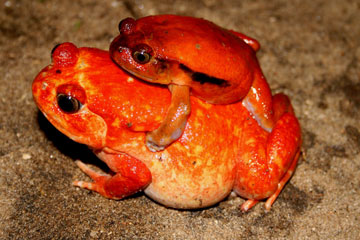 Mating Tomato Frogs (Dyscophus antongilii). Photo by Dr. Franco Andreone. |
Franco Andreone:
By analyzing the very rich herpetological collection still present, formed during the 18th and 19th Century, I became aware of the work of the famous herpetologist Mario Giacinto Peracca. Peracca lived in 1861-1923, and he described several species of amphibians and reptiles from Madagascar. The analysis of “his” animals (still housed in the Museum) really excited me and were the starting point for my growing interest in Madagascar. Then I read very interesting papers by a Netherlander researcher, Rose M.A. Blommers-Schlösser; the first with color plates of live frogs of Madagascar. After this I made some preliminary fieldtrips with the aim to photograph those creatures, and soon became aware that they were threatened by the ongoing habitat alteration and degradation and by the increasing pet-trade.
Mongabay: How do studies in Madagascar differ from your usual work on European species?
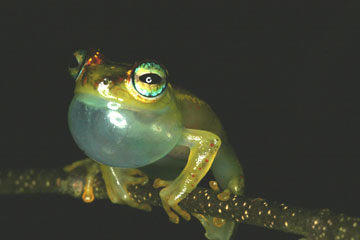 Betampona (Boophis bottae), a member of the Mantellidae family. Photo by Dr. Franco Andreone. |
Franco Andreone:
Well, of course the herpetofauna of Madagascar differs greatly in number and forms from the European one. With around 240 frog species currently known (and many others still waiting to be described) Madagascar is at the top of frog diversity. Living in Italy, anyhow, I have the advantage to be in a country with an already rich fauna. In the end the studies and the approaches are not so different. It is always a matter of interaction between humans and natural habitats. With the only difference that in Madagascar the problems are much more difficult to solve, still lacking a diffuse culture of considering small creepy creatures and their habitats worth protecting. But the advantage in Madagascar is that the conservation of biodiversity and ecotourism are among its first resources. Taking this in mind we hope that the conservation of the fauna and flora and their preservation in future will become a reality.
Mongabay: Have you made discoveries of new species in Madagascar?
Franco Andreone: Well, frogging in Madagascar gives you the chance to discover new species almost every day! As I said there are about 240 known species of amphibians in Madagascar, but I believe, according to our data and the still undescribed species I found in the last years (most of them are still unnamed), that the total number of frogs will be around 500! This means that simply describing species will keep me busy for many years. But, it is important to note, that the description of new species is functional to conservation. The name of a species is important in protecting it!
Mongabay: How would you describe the conservation situation in Madagascar?
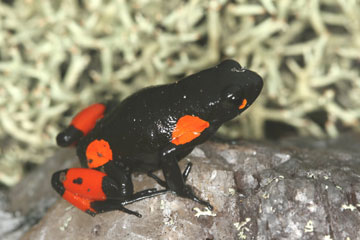 Mantella cowan is Madagascar’s most endangered frog known to scientists. Photo by Dr. Franco Andreone. |
Franco Andreone:
As many of your readers know, Madagascar’s territory is largely deforested. This is particularly evident on the central high plateau. Because of this, efforts should be carried out to save the residual areas with dense vegetation and high biodiversity. The actions drawn by the MAP (Madagascar Action Plan) are integrated with the so-called “Durban Vision”, a program indicated by President Marc Ravalomanana to triple the protected areas of Madagascar. This is indeed a real change for Madagascar. Most recently I participated in a workshop dedicated to climate change, which is another aspect that needs to be taken into account: the increase in observed temperature and those projected in the future poses important questions for any conservation action. I am very interested to see how Madagascar develops in the next few years, with the need to share biodiversity conservation with human development. Amphibians and reptiles — my favored animals — play an important role in the biodiversity conservation. For these small animals it is important that the conservation actions are oriented towards the safeguard of small areas, where residual forests still survive. The protection of these “focal areas for amphibian and reptile conservation” is crucial. For example, we are currently looking at how to protect the most threatened amphibian species of Madagascar, the Harlequin Mantella (mantella cowani). Its residual habitats are not yet integrated into the protected areas of Madagascar. To incorporate them there is a project to purchase one of the most important areas for the species, and thus transform it into a real sanctuary for frog conservation, the first one in Madagascar. An important step for conservation, indeed.
MUSEUM WORK
Mongabay: As curator of the Museo Regionale di Scienze Naturali in Torino how much time are you able to give to the museum considering all your fieldwork?
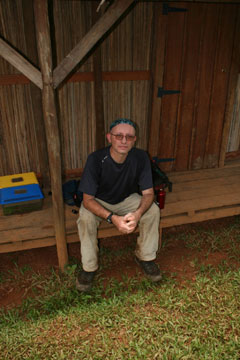 Dr. Franco Andreone. |
Franco Andreone:
I must say that time is one of the major limits for my activity. Being curator of herpetology at Turin I have to deal with the daily and important curatorial activities, which include the collection, management, study, and preparation of exhibits. Notwithstanding, it is my deep conviction that field-conservation is a plus-value for a natural history museum. Due to this, I am very happy to be able to travel to Madagascar several times a year. I must confess that I cannot stay as long as I would like, but spending 2-3 months a year in Madagascar I am able to do some good work as well.
Mongabay: What are some of your highlights from the past sixteen years working at the museum?
Franco Andreone: Well, I am also concerned with boostering a new vision of the activities done by curators in a museum. Collecting data for the frogs of Madagascar I am also able to transpose, as I told before, experiences in a far country into the Italian reality.
Mongabay: What do you feel is the role of the Natural History museum in today’s society?
Franco Andreone: Museums are an ideal place to show the direct result of conservation actions. Museums, in my opinion, should also play a more important role in nature conservation. Showing – of course – the stuffed animals, but also showing that studies are still being conducted, and they are no longer conducted just for collections’ sake but to promote wildlife conservation. I must say that it is not easy to convince the local administrators of this need. In Italy the task is much more difficult, taking into consideration that we lack a big national museum and that small-medium natural history museums are often more sensible and interested in promoting local awareness actions. I hope that my work will be useful.
HEPETOFAUNA THREATS AND CONSERVATION
Mongabay: What do you see as the greatest threat to herpetofauna?
Franco Andreone: The greatest threat is habitat alteration. Losing fragments of natural habitat is often a big problem for amphibians and reptiles. In some case, moreover, the capture for the pet-trade could be a problem indeed, especially when the terrarium keepers promote the capture of rare animals, still surviving in small areas.
Mongabay: Do you believe climate change is a significant threat to herpetofauna?
Franco Andreone: Climate change will have a clear effect on the herpetofauna. In Madagascar it is evident that the species living in the delicate rainforest ecosystems and at high altitude will suffer and, in the end, will see their natural habitats considerably reduced. On the contrary, species more typical of dry areas will show an augment in their distribution. But these are only previsions. Much work still remains to be done on this subject.
Mongabay: How has your experience been working with such well-known conservation organizations, such as WCS, WWF, IUCN, and EDGE?
Franco Andreone: It has been a great opportunity and pleasure, and I am always very interested in collaborating with these big organizations and initiatives. They offer a wider scope on conservation problems, and it is very nice to see that amphibians and reptiles have become in the last years important biodiversity elements.
Mongabay: Amphibians have begun to receive increased attention from conservation organizations due to their great vulnerability–programs like EDGE and the Amphibian Ark are working specifically on amphibians. Do you think enough is being done to stave off massive amphibian extinction?
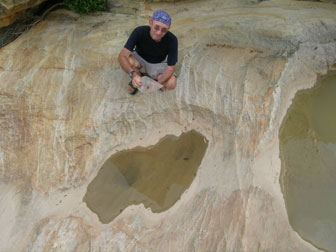 Habitat of Mantella expectata at Isalo Massif. Dr. Franco Andreone. |
Franco Andreone:
Difficult to say. In general, I believe that we will observe repeated and sometimes small local extinctions. Only the species with very small distribution areas will suffer heavily from habitat alterations and pathologies. I am thinking, for example, of high altitude endemics and species that live next to human pollutions. In other cases it will be difficult to understand the loss in terms of amphibian biodiversity. In Madagascar it’s necessary to increase collecting data in the wild, since for many species we do not even have information about the sexual dimorphism, simply because the species is known from a limited number of individuals held in natural history museums. Anyhow, amphibians will decrease in numbers all around the world, excepting, as usual, for the introduced and exotic species. I am thinking, for example, of the big cane toad (Bufo marinus), introduced in Australia; the huge bullfrog Lithobates catesbeianus, that is also a vector of the amphibian chytrid fungus; and of the African clawed frogs Xenopus laevis. These species, where introduced, have proven to be real pests. But the small and tiny frogs of the Malagasy rainforests are really next to catastrophic declines if — for example — the amphibian chytrid fungus (currently said to be absent in Madagascar) is accidentally introduced.
Mongabay: What additional conservation steps would you like to see happen?
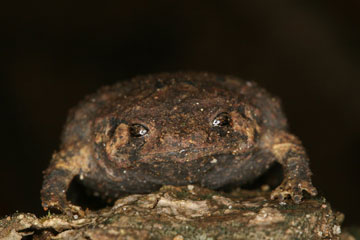 Rhombophryne coudreaui is listed as vulnerable by the IUCN. Photo by Dr. Franco Andreone. |
Franco Andreone:
For Madagascar it is important that a “road map” for the conservation is designed and strictly followed. We developed such a document as chairs of the Amphibians Specialist Group of IUCN. The “Sahonagasy Action Plan” (SAP for brevity–“sahona” is the Malagasy name for the frogs) has been realized within the framework of the ACSAM Iniative. The ACSAM (A Conservation Strategy for the Amphibians of Madagascar) is a program just conceived for promoting the amphibian conservation in Madagascar (see www.sahonagasy.org). The SAP will be printed in the next months and will be distributed to the competent organizations, authorities and researchers. It will give clear information on what to do to booster the frog conservation in Madagascar. The final budget for about 5 years of actions is estimated at around 2,000,000 EUR. We strongly hope that environmental organizations and potential donors will support this cost. If this happens we may imagine the beginning of a new era for amphibian conservation. This regional action plan, together with other similar ones, could become a model for a global amphibian conservation strategy.
Mongabay: Do you have any advice for students hoping to become conservation scientists?
Franco Andreone: It is difficult to say, but I believe the love of nature and its creatures must go together with an interest for human development. Then, skipping from local to global, you understand that it is impossible to deal with great themes without being familiar with what happens near to us. The contrary is also true: sometimes problems at small scales are just the consequence of what happens at a higher level. For example, global warming affects animals living in the meadows next to our towns, and the chytrid fungus (Bartrachochytrium dendrobatidis) an emergent pathology—which affects populations and species of frogs around the world—is now present in Europe.
Mongabay: What can the public do to help conserve biodiversity, especially herpetofauna?
Franco Andreone: First of all it is important to increase public awareness. Education plays an important role for the public to learn that frogs, toads and salamanders are not only beautiful and interesting animals, but are part of the great diversity of life. Their protection and conservation is, in the end, the protection of our common world. Then it is important to do our best to save not only the big forests of the tropics where huge amphibian diversity is present, but also the small natural habitats that we still have in our countryside. The conservation of a small pool and the natural environments surrounding it is often a way to save important amphibian populations. Better information and a careful management of the natural habitats are the best way to conserve biodiversity all around the world. Donations to the Amphibian Specialist Group and associate programs will help to conduct field surveys on the threatened batrachofauna, and to purchase the last fragments of focal areas for amphibians.














